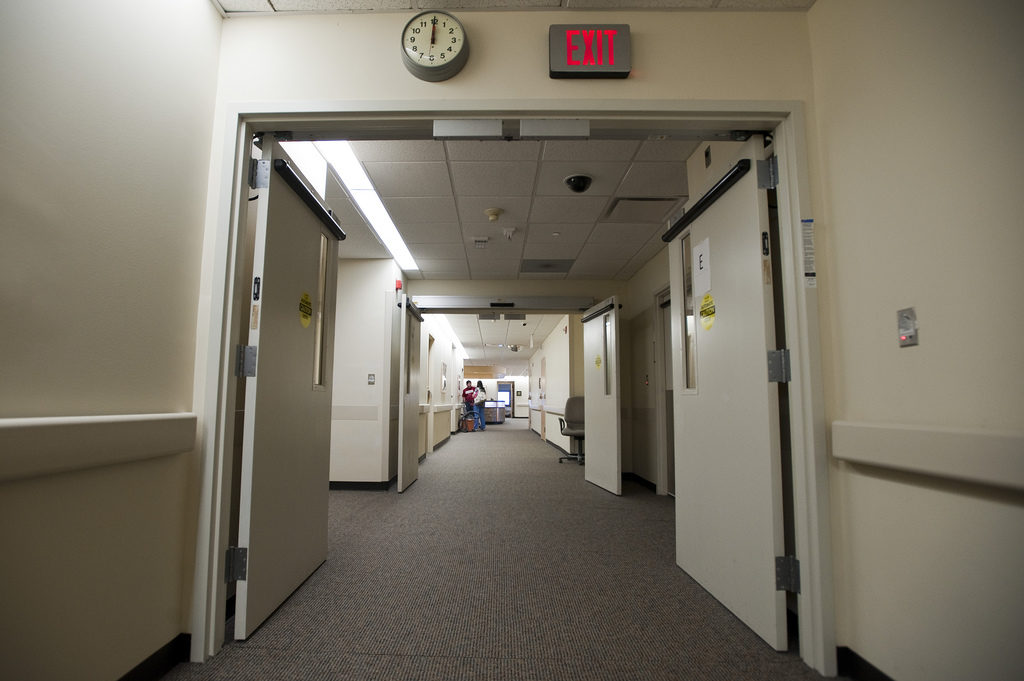A new meta-analytic study published open-access in JAMA Psychiatry this week synthesizes over fifty years of research on suicide rates following psychiatric hospitalization. They find that suicide risk post-hospitalization is 100 times greater than average immediately following discharge. Suicide risks remain significantly elevated for years following this experience.
“Our data suggest that the suicide rates among discharged patients have not decreased in the past 50 years,” the authors write. “This is a disturbing finding considering the increase in community psychiatry and the availability of a range of new treatments during this period.”

Last year, Mark Olfson and colleagues examined Medicaid data of patients hospitalized with a diagnosis of depressive disorder, bipolar disorder, schizophrenia, or substance use disorder. They found that these patients were 15 times more likely to commit suicide than similarly matched patients who were treated for non-mental health issues. (See MIA report)
The researchers of this latest study note, however, that while past studies have “described the phenomenon of postdischarge suicide as a ‘nightmare and disgrace,’ these views may have actually been formed in reaction to underestimates of the problem.
“We agree,” they write, but “our meta-analytic estimate during the same duration of follow-up is more than 6 times higher.”
This study aimed to examine what progress had been made in postdischarge suicide rates, and how these rates play out over time. The study followed the Meta-analysis of Observational Studies in Epidemiology (MOOSE) and Preferred Reporting Items for Systematic Reviews and Meta-analyses (PRISMA) guidelines. A total of 100 studies with 183 separate samples of discharged patients from different countries were included in this analysis.
The analysis revealed a pooled suicide rate after release of 484 per 100 000 person-years, but the rate per sample varied somewhat widely. There was a distinct trend toward higher suicide rates in more recent studies. The difference in suicide rates after hospitalization did not differ significantly by country or geographic location.
It is important to note that while the risk is increasing and is much greater than the general population, these statistics suggest that roughly 0.28% of all discharged patients die by suicide within the first three months after leaving the hospital.
In total, adolescents and older patients both had lower suicide rates than adult samples. Patients with diagnoses of psychosis, affective disorder, and mixed other diagnoses had similar suicide rates, but patients who were originally admitted for suicidality were at an increased risk. Suicide rates did not differ significantly by sex.
“We identified a large number of studies reporting more than 17 000 suicides in almost 5 million person-years at a pooled rate of 484 per 100 000 person-years,” the authors write.
“This figure is more than 3 times the suicide rate estimated in a comparable study of the suicide rate among inpatients and 44 times the global suicide rate of 11.4 per 100 000 patients per year in 2012.”
The researchers state that their results “should curb enthusiasm for restrictive interventions” that attempt to target certain patient groups labeled as “high risk” for suicide.
****
Read the full study open-access here: http://jamanetwork.com/journals/jamapsychiatry/fullarticle/2629522















my best guess is that being ripped out of the community, stigmatized, drugged up, labeled, and often completely broken drives a lot of people (“patients”) to suicide. Abandon all hope, ye who enter here…
Report comment
The first time I visited a psych ward, my first thought was, “Wow, if you weren’t depressed before you arrived her, you’d sure be depressed afterwards!
Report comment
Yes. I had a patient tell me we were supposed to be safe here and then say but if I wanted to I could stick a pencil in your ear. Constantly follow me around day and night talking about judgement day. A woman gave me a pornographic picture. Rooms were searched routinely. Activities included painting bird houses and watching videos about the benefits of ECT. I now live in constant fear of any doctors and police or paramedics.
Report comment
Yes, my experience was that being kidnapped, locked up and drugged against my will when I had done nothing wrong was THE single most traumatic experience of my life. And yes, within three months of discharge I very nearly succeeded in suiciding. Another woman on the ward succeeded within a week of her discharge.
They totally shattered my trust in justice and human rights, and to this day (over 10 years later) I still am very fearful of seeing a medical doctor for any complaint at all – I have a trauma reaction from the instance I suspect I need to see one that takes a week or two after the visit to fully settle.
I now see doctors as totally untrustworthy and as operating outside the law and as people who can lock me up and deprive me of my human rights without need for cause and without any real checks and balances.
Really, I dont understand why “normal”, non-psychiatric doctors don’t work to get psychiatry thrown out of the medical profession as it has no evidence base and brings the rest of the profession into disrepute.
Report comment
“I dont understand why ‘normal,’ non-psychiatric doctors don’t work to get psychiatry thrown out of the medical profession as it has no evidence base and brings the rest of the profession into disrepute.” It’s because the psychiatrists cover up their malpractice. But I do agree, I’ve lost respect for the entire medical community as well.
Report comment
I think the idea that non psychiatriatrci Dr’s should work to end psychaitry is an interesting one and worth investigating.
Report comment
John,
The psychiatric drugs industry makes a lot of money – and Psychiatry brings a lot of this money into medicine.
It’s like one hand washing the other at the expense if the taxpayer.
Report comment
Just read this article, which explains malignant normality –
a state I believe our medical doctors – of all sorts (remember GP’s do harm with these and other drugs, too)
https://www.dissentmagazine.org/article/malignant-normality-doctors
Report comment
Jan, that’s a great article. I am a Lifton fan due to his extensive work on cults. I agree that the degree of conformity to atrocity such as torture leads to such practices being seen as normal or okay. It’s hard when I find myself all alone in certain circles speaking of mental health care as genocide, spreading fear, hatred, and loathing of a group of people for nonexistent inferiority.
Report comment
Yes at 64 and a male I feel the way you do but I have been in panic mode 24/7 for several yrs since being in where I was taunted/tortured by other patients. I am barely surviving. I have not been outside for months. Reading about others makes me feel worse. I feel paralyzed in my own skin.
Report comment
Anyone with a brain in their head should know that forcibly holding an innocent person against their will, taking away their rights, massively chemically raping (“snowing”) them, lying to them claiming they have a “life long, incurable, genetic mental illness,” thus attempting to take away all their hope – this is behavior which would indeed and unquestionably increase suicides. But the power drunk, but apparently brainless, psychiatrists don’t understand this.
One of the psychopathic doctors who did this to me was finally convicted by the FBI, for having lots and lots of patients medically unnecessarily shipped long distances to himself, “snowing” these patients, then having unneeded tracheotomies performed on them for profit. He and his psychiatric “snowing” partner in crime, who has not yet been arrested, defrauded $30,000 from my health insurance company for their “snowing” crimes against me.
https://www.justice.gov/usao-ndil/pr/oak-brook-doctor-convicted-kickback-scheme-sacred-heart-hospital
Thankfully I survived the “snowing,” and avoided the tracheotomy, despite being admitted with a non-existent “chronic airway obstruction,” according to their medical records. These doctors were not able to explain how a non-existent “chronic airway obstruction” magically turned into “bipolar,” however, and the lawyer from that hospital claimed such illegal maltreatment was, according to Advocate “Good” Samaritan hospital, “appropriate medical care.”
The right of doctors to hold people against their will and force treat anyone should be taken away, it’s being abused by criminal doctors, and it’s increasing suicides societally dramatically, for obvious reasons. These medical crimes were committed against me to cover up prior easily recognized and complex iatrogenesis, to proactively prevent a legitimate malpractice lawsuit, as well as to cover up medical evidence of the abuse of my child by doctors who like to profiteer off of illegally covering up medical evidence of child abuse for the ELCA religion, who owns Advocate “Good” Samaritan hospital.
How low can the medical and religious industries go? I would be just one of the MANY ‘widows’ mentioned in the Preface of this book discussing the massive cover ups of child abuse by the bishops of the ELCA Chicago synod offices. Check out the chapter on evil, too.
https://www.amazon.com/Jesus-Culture-Wars-Reclaiming-Prayer/dp/1598868330
Of course a way too paternalistic society would include within its power structure industries whose primary actual function is covering up the rape of children, I guess? Gross. Yeah to the psychological and psychiatric industries, whose own medical literature shows that this is their primary actual function within our society given that, “the prevalence of childhood trauma exposure within borderline personality disorder patients has been evidenced to be as high as 92% (Yen et al., 2002). Within individuals diagnosed with psychotic or affective disorders, it reaches 82% (Larsson et al., 2012).”
And the psychiatric industry’s recommended treatment for both “borderline” and the “psychotic or affective disorders,” which encourage combining the antidepressants and/or antipsychotics, can create what appears to the doctors to be both the negative symptoms of “schizophrenia” and the positive symptoms of “schizophrenia,” via neuroleptic induced deficit syndrome and anticholinergic toxidrome.
https://en.wikipedia.org/wiki/Neuroleptic-Induced_Deficit_Syndrome
https://en.wikipedia.org/wiki/Toxidrome
But the “mental health professionals” claim they don’t know about these psychiatric drug induced illnesses, since these drug induced illnesses are conveniently NOT included in the psychiatrists’ scientifically invalid, billing code “bible.” How low can the “professionals” go?
The right of psychiatrists to imprison and create “mental illnesses” in innocent people and child abuse victims for profit, en mass, should be made illegal, since it technically is illegal. But it’s totally understandable why such greed inspired injustice and ungodly disrespect are resulting in enormous suicide rates. Congratulations to the psychiatric industry on your continuing, unrepentant mass murders of innocent humans.
Report comment
Unnecessary tracheotomy? That’s sickening.
Report comment
Yes, some doctors are definitely “sickening.” And the fact that the mainstream medical community utilizes the psychiatrists to cover up child abuse and their malpractice on a regular basis, and this is known as “the dirty little secret of the two original educated professions,” according to an ethical pastor of mine, makes the lot of the mainstream medical community look pretty “sickening.”
No doubt the psychiatrists know that keeping the child molesters on the streets, raping more and more children, is “good for business.” But it’s not good for the majority within society, especially the children.
The high school in the neighborhood where the rapists of my child lived had the highest suicide rate in the nation, by the time my child was in high school. Coincidence? I doubt it, especially since the pastor who had me poisoned to cover up the abuse of my child was the one running an organization which was pointing out the “at risk children.”
It’s rather sad, we’re living in a world where those professions that used to be respectable – bankers, doctors, lawyers, judges, pastors, bishops – no longer are. And to the contrary, “the ones we hail Are the worst of all.”
Report comment
All I can think of to explain how they live with their consciences is a mental process called “dehumanization.” Because they don’t see us as truly human they imagine we don’t suffer the way they or other people would. We don’t have the same needs as others. We don’t bleed red.
Report comment
To protect the patient from hurting or killing themselves the obvious solution is to keep the patient/prisoner in hospital/jail .
The helpers now have scientific evidence now to support unlimited hospitalization/detention.
http://www.smbc-comics.com/index.php?db=comics&id=2879#comic
Report comment
If researchers want to know why “certain people” attempt suicide, then I think it’s important that they ask them why they do. Speaking from my own case it was the “medication”.
Report comment
For me it was losing all my friends, being kicked out of college. Also the emotional and verbal abuse from Mom and occasional physical blows from Dad. Neither of them treated me that way till they found out I was a mentally ill monster.
I believed my soul would be sent to Hell if I killed myself. But do the mentally ill have souls, seeing we rely on pills instead of consciences? Plus I owed it to humanity to relieve them of my presence. That was because of my “good insight.” That’s probably behind many suicides.
Report comment
As someone who struggles with suicidaltiy, I’ve journaled about it a LOT and the mere thought of forced incarceration should I ever slip up and mention it to a ‘mental health professional’ overwhelms me with utter despondency and the feeling like I would go thru with it if I was forcibly ‘treated’, sigh…
Report comment
Samruck2
So how does one like me who has no one left and has been forcefully been put into psych hospitals deal with constant suicidal thoughts? I just can’t go back there again. I’m not asking for a reply. It is just a question of desperation for those of us who did not avoid the system. I remember myself in the good times when I traveled, sailed, taught, had hopes and dreams of someday meeting a mate and look at those around me who are free to come and go as they please even just going to the beach when I literally live in terror 24/7.
Report comment
I’m guessing the reason why you feel suicidal is because no one is there, right? Isolation happens because of psych care, not because of any negative quality you have. It’s because you went to them and they gave you a phony diagnosis. It is due to what THEY did, not because of what you did. So you need to stop believing the diagnosis, and live your life as YOU. Because you are that person who is autonomous who does not need them, who lived a beautiful life without them and can do this again. Because you deserve a mate, and because someone out there will truly benefit from knowing you, and because you have much to give. Go find people and show them you are an awesome person who isn’t a label.
Report comment
HSN, I’m a great vent partner. We women do that more, but if a man like you is lonely and needs someone just to hear your pain my email address is r dot nichols 42 at yahoo dot com. I also skype. You do matter!
Report comment
HSN,
I devise different ways to give me HOPE. For me that seems to be the #1 key to the level of suicdality that I feel. When my hope of things ever getting better between me and my wife dims, then my suicidality increases, but as I feel more hopeful that some day things will get better, it decreases. So I constantly find new, little focuses that give me hope in the midst of our battle with her d.i.d.
Sam
Report comment
Of course the risk of suicide is going to be greater. The risk of any psychotic behavior is going to be greater because the psychotropic medications that they are given, or are forced to take, make them that way.
Report comment
And the suicide is intentional. I know that’s stupid to say, but the suicide risk for drug overdose also spikes after leaving treatment/institutionalization (hospital, rehab, prison), and many experts claim it’s due to ‘lost tolerance’. This is a dangerous misconception. I’m sorry for the people who want to kill themselves (hang on – it’s about to get real!), but please don’t say it was ‘an accident’. This only gives others an easy excuse.
Report comment
When I quit thinking about suicide, I became very angry. I’m not homicidal btw; my anger is more constructive than my prolonged sadness as a mental prisoner.
Report comment
The perps are the staff.
Report comment
I think these comments sum it up nicely. INCARCERATION is deeply harmful. It’s not care, it’s not protection, and it’s inherently wrong. After and during incarceration patients/inmates are lied to, told they “needed” it and that it was all justified. Most believe the outright lies, believe they were “ill.” A parallel is when a rape victim is told, “You needed that,” or, “You were asking for it.”
For those of us who were wrongly accused of suicidality, the harm done in such gaslighting can result in hopelessness and despair after incarceration.
Justin, thanks for bringing this to the public. I’ll be sharing.
Report comment
Incarceration is deeply harmful, but insisting on calling it “treatment” and expecting the prisoner to appreciate your kindness is even worse! If they’d at least admit they’re imprisoning you, it would be a step in the right direction!
Report comment
I’m all for eliminating suicide. Or reducing it as much as possible. People usually kill themselves because they suffer and perhaps think they owe suicide to those around them.
Go to the suicidal person. Tell him/her how important they are to you, how you would miss them if they died. Give them a hug. Ask if there is anything you can do to ease their pain.
Get at least 2 or 3 friends to take turns watching the friend if they still give you cause for worry. Make sure they get good, nourishing food, water, rest, fresh air, sunshine or a spectrum lamp, and exercise. Let them vent or remain silent as they choose. If they vent, speak as little as possible yourself and don’t condemn them.
When the person is able to reason, help them find a way out of the mess and make plans for a future. Something to hope for.
Does that really require 12 years of college?
Report comment